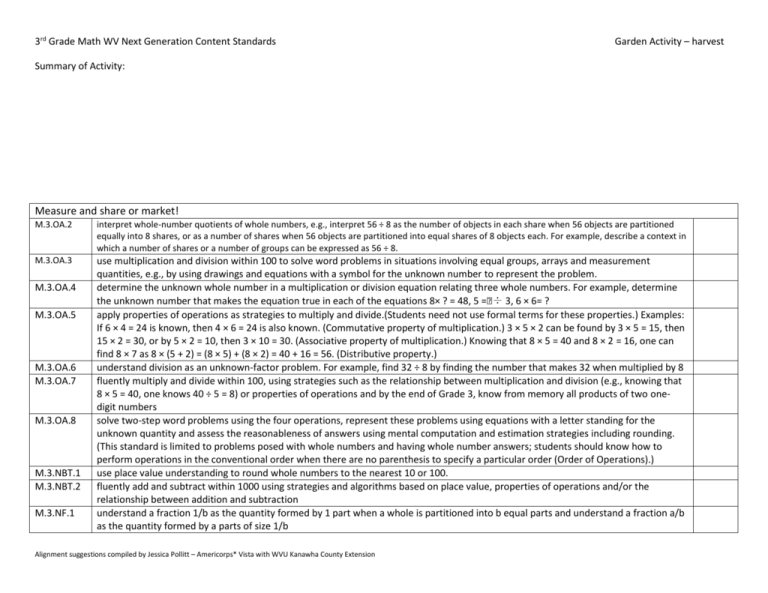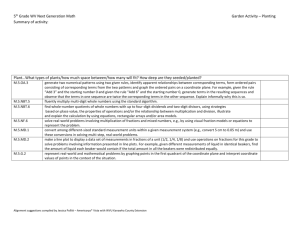3rd Grade Math checksheet – Harvesting
advertisement

3rd Grade Math WV Next Generation Content Standards Garden Activity – harvest Summary of Activity: Measure and share or market! M.3.OA.2 interpret whole-number quotients of whole numbers, e.g., interpret 56 ÷ 8 as the number of objects in each share when 56 objects are partitioned equally into 8 shares, or as a number of shares when 56 objects are partitioned into equal shares of 8 objects each. For example, describe a context in which a number of shares or a number of groups can be expressed as 56 ÷ 8. M.3.OA.3 use multiplication and division within 100 to solve word problems in situations involving equal groups, arrays and measurement quantities, e.g., by using drawings and equations with a symbol for the unknown number to represent the problem. determine the unknown whole number in a multiplication or division equation relating three whole numbers. For example, determine the unknown number that makes the equation true in each of the equations 8× ? = 48, 5 =�÷ 3, 6 × 6= ? apply properties of operations as strategies to multiply and divide.(Students need not use formal terms for these properties.) Examples: If 6 × 4 = 24 is known, then 4 × 6 = 24 is also known. (Commutative property of multiplication.) 3 × 5 × 2 can be found by 3 × 5 = 15, then 15 × 2 = 30, or by 5 × 2 = 10, then 3 × 10 = 30. (Associative property of multiplication.) Knowing that 8 × 5 = 40 and 8 × 2 = 16, one can find 8 × 7 as 8 × (5 + 2) = (8 × 5) + (8 × 2) = 40 + 16 = 56. (Distributive property.) understand division as an unknown-factor problem. For example, find 32 ÷ 8 by finding the number that makes 32 when multiplied by 8 fluently multiply and divide within 100, using strategies such as the relationship between multiplication and division (e.g., knowing that 8 × 5 = 40, one knows 40 ÷ 5 = 8) or properties of operations and by the end of Grade 3, know from memory all products of two onedigit numbers solve two-step word problems using the four operations, represent these problems using equations with a letter standing for the unknown quantity and assess the reasonableness of answers using mental computation and estimation strategies including rounding. (This standard is limited to problems posed with whole numbers and having whole number answers; students should know how to perform operations in the conventional order when there are no parenthesis to specify a particular order (Order of Operations).) use place value understanding to round whole numbers to the nearest 10 or 100. fluently add and subtract within 1000 using strategies and algorithms based on place value, properties of operations and/or the relationship between addition and subtraction understand a fraction 1/b as the quantity formed by 1 part when a whole is partitioned into b equal parts and understand a fraction a/b as the quantity formed by a parts of size 1/b M.3.OA.4 M.3.OA.5 M.3.OA.6 M.3.OA.7 M.3.OA.8 M.3.NBT.1 M.3.NBT.2 M.3.NF.1 Alignment suggestions compiled by Jessica Pollitt – Americorps* Vista with WVU Kanawha County Extension M.3.NF.3 M.3.MD.2 M.3.MD.3 M.3.MD.4 explain equivalence of fractions in special cases and compare fractions by reasoning about their size a. understand two fractions as equivalent (equal) if they are the same size or the same point on a number line, b. recognize and generate simple equivalent fractions, e.g., 1/2 = 2/4, 4/6 = 2/3) and explain why the fractions are equivalent, e.g., by using a visual fraction model, c. express whole numbers as fractions, and recognize fractions that are equivalent to whole numbers (Examples: Express 3 in the form 3 = 3/1; recognize that 6/1 = 6; locate 4/4 and 1 at the same point of a number line diagram.), d. compare two fractions with the same numerator or the same denominator by reasoning about their size, recognize that comparisons are valid only when the two fractions refer to the same whole, record the results of comparisons with the symbols >, = or < and justify the conclusions, e.g., by using a visual fraction model measure and estimate liquid volumes and masses of objects using standard units of grams (g), kilograms (kg) and liters (l) (Excludes compound units such as cm3 and finding the geometric volume of a container.) and subtract, multiply or divide to solve onestep word problems involving masses or volumes that are given in the same units, e.g., by using drawings (such as a beaker with a measurement scale) to represent the problem. (Excludes multiplicative comparison problems – problems involving notions of “times as much”.) draw a scaled picture graph and a scaled bar graph to represent a data set with several categories and solve one- and two-step “how many more” and “how many less” problems using information presented in scaled bar graphs. For example, draw a bar graph in which each square in the bar graph might represent 5 pets. generate measurement data by measuring lengths using rulers marked with halves and fourths of an inch and show the data by making a line plot, where the horizontal scale is marked off in appropriate units—whole numbers, halves or quarters Alignment suggestions compiled by Jessica Pollitt – Americorps* Vista with WVU Kanawha County Extension





